Way back in 1892, the US Government adopted their first official bolt action rifle, the 1892 Krag Jorgensen Rifle. Prior to that, the military was using the Trapdoor Springfield (1873 model) and before that, they were using the Allen Conversion of the Civil War muskets.
So, with the Krag in service from 1892, various other models were also issued (like the ’92, ’94, ’96, ’98 and ’99) until the ’03 was adopted. To read more about this rifle, Bill Brophy’s book of the Krag comes highly recommended.
However, the US Army became frustrated with having to reload the Krag with individual cartridges in a spring-loaded port in the starboard side of the rifle and they were looking at the German Mauser that loaded from the top with 5 rd. stripper clips.
Then in the late 19th century, Springfield began several experiments with the Mauser Patent. It was in 1903 when they adopted the ’03 Springfield that utilized a ctg. firing a 220-grain bullet at about 2300 fps. Before, the 30-40 Krag had already fired the same projectile at 2000 fps. The US Army felt the increased velocity was necessary to compete with the Spanish Mausers they experienced during 1898 in Cuba. So, the ’03 was born because the original Krag’s single locking lug couldn’t accommodate the increased chamber pressures of a hot-rodded cartridge.
German experiments resulted in the spitzer bullet. Pointed with a boat-tailed rear end, the improvement became the renowned .30-’06 cartridge that was used in the military until after 1965. The original cartridge was called the .30 Government, which is also sometimes referred to as the .30-’03 to differentiate it from the .30-’06.
Originally, the rifle was known as the U.S. Magazine Rifle, Model of 1903. Complete with a device on the left of the receiver, called a magazine cut off that prevented troops from wasting ammo. The cut off allowed the magazine to be filled with 5 rounds. With the cut off disabled, the rifle did single shots. With the cut off enabled, 5 successive rounds could be shot without reloading.
Because of the apprehension regarding the uniformity of the new service rifle’s bore diameter, a bore measuring device known as the star gage was used. This device had extensions to reach into the lands and grooves to measure the barrel size. The Krag Rifles lacked uniformity so around 1905, the star gage was created to correct the defect.
However, by 1909 more modern methods of rifling the ’03’s barrels resulted in over 90% of new rifles passing the star gage test. Shortly thereafter, star gaging was discontinued although some manufactured rifles were still star gage tested to ensure uniformity.
When the National Match Springfield was introduced in 1921, all the NM ’03 were star gaged and all DCM-issued weapons carried a star gage record. If a barrel was star gaged, it was marked with a small sunburst image at the 6 o’clock position on the muzzle’s crown. Note that Match ’03s manufactured prior to 1921 typically won’t have this mark.
Before the buildup to WWII, Springfield Rifles were manufactured at Springfield Armory and Rock Island Arsenal using two different serial number ranges. By 1917, they realized there were insufficient ’03s to arm the number of US troops enlisting for the Army. So, the ’03 was supplemented by the 1917 pattern Enfield rifle made by Winchester, Remington and Eddystone. But after the war, the 1903 was restored as the standard issue rifle.
Before 1918, there was a long inquiry into reports of burst ’03 receivers, which revealed nuances in forging ’03 receivers at Springfield and Rock Island. Under scrutiny, most receivers were considered perfect with a select few that were questionable. After changing the metallurgical process by including a double heat treatment, the new receivers got the 800,001 serial numbers at Springfield Armory and serial numbers from 285,507 were given to receivers made at Rock Island Arsenal. Rifles with serial numbers below these ranges are best fired with factory loads or rather used as a collector’s items.
Over time, minor changes were applied like adding stock bolts to absorb the recoil without cracking the stock. There were adjustments to the handguard and the removal of the checkering on the buttplate (except for the National Match and .22 cal. training Models). Stock variations included:
- Type S Straight grip with finger grooves
- Type C Pistol grip without finger grooves.
- Type S (W.W.II variation) Straight grip without finger grooves.
Models of the 1903 Rifle:
- 1903 Type S Stock: Cut for the Pedersen Device ejection port on the left with a Mark 1 designation.
- 1903A1 Type C Stock: Most rifles were National Match weapons or late models produced by Remington in W.W.II.
- 1903A2: Use of a barreled receiver as a sub-caliber firing device for a tank cannon.
- 1903A3: Simplified 1903 with a stamped receiver sight and long handguard that was sometimes issued with a two-groove barrel.
- 1903A4 Sniper Model with M73B1 scope: Most were marked M1903A3 on the left of the receiver to be visible when the scope blocks were mounted. Both types are mounted in type C pistol grip stocks.
There were a number of attempts to increase the ’03 firepower.
First, was the Mark 1 made to utilize the Pedersen Device that plugged into the receiver in place of the bolt. A crucial component of the device is the insert that filled the .30-’06 chamber and the firearm was fitted to shoot an extra long .32 auto cartridge. This resulted in a pistol slide on top of the device to cock and chamber the round. It was semi-automatic with a 40-round magazine snapped onto the right side of the device. The bullet weight was 80 grains with a muzzle velocity of about 1300 fps. An estimated 65,000 devices were manufactured but later destroyed in the 1930s and the Mark 1 Rifles returned to normal service.
Secondly, was plugging a 20-round box magazine into the bottom of the magazine well in place of the floorplate. But the magazine was so solid and heavy, excluding the weight of the ammo, that it wasn’t very practical and therefore it wasn’t applied as a popular approach.

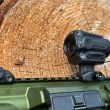
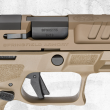
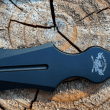
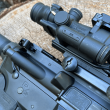

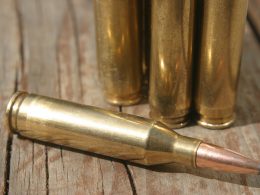
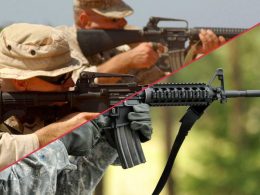
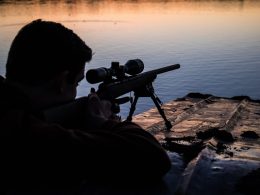
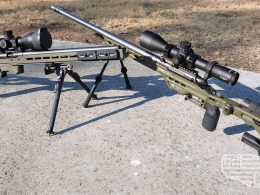

Is there any record of the Remington M1903 rifles being used by the Marine Corps in WWII? I’ve looked but have found nothing other than a brief mention, using the word ‘reported’, in Bruce Canfield’s paper on The Remington M1903 Rifles.